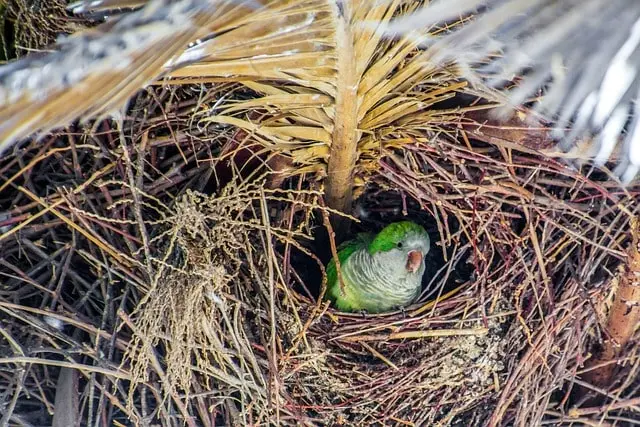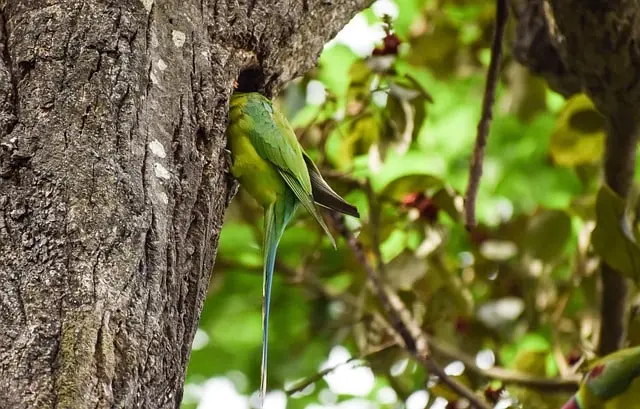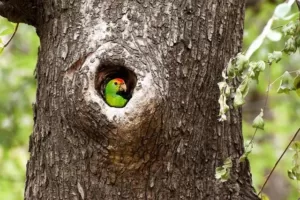Parrots are tree-dwelling species that inhabit forested areas, where they can forage food easily. Because of their varied diet, parrots are quite flexible in selecting their nesting site. However, their nesting habits are influenced by several factors including the availability of suitable cavities.
Parrots do not excavate new cavities, instead, they occupy existing ones. So they need to be careful while selecting their nest as it directly impacts their breeding success.
Most parrots nest in tree cavities excavated by other birds. Since birds typically leave their nest after the breeding season, there are plenty of vacant cavities for parrots to move into. Besides tree cavities, parrots also prefer other types of nests and colonies to inhabit including cliffs, termite mounds, and even large cacti.
Quick Navigation
Which Parrots Make Nests?
There are only a few species of parrots that make nests. According to The Auk: Ornithological Advances, only five species of African lovebirds, along with Monk Parakeets, are known to construct nests.
The Monk Parakeet is known for building bulky nests on tree tops and city towers, often made of twigs and sticks. These nests are quite large and contain multiple chambers for several breeding pairs to reside.
On the other hand, the four species of the African lovebird, namely the Yellow-collared lovebird, Fischer’s lovebird, Lilian’s lovebird, and Black-cheeked lovebird build round nests inside hollow spaces, while the fifth species, the Rosy-faced lovebird construct cup-shaped nests within cavities.

Why Do Most Parrots Nest In Cavities?
Parrots nest in cavities to protect themselves and their young from predators. The risk of predation can be higher during the breeding season for birds that nest on branches. Tree cavities provide parrots with a safe shelter and prevent them from being spotted easily. Cavities are also safer than open nests because they protect parrots from weather changes and rainfall.
How Do Parrots Build Their Nests?
Most parrots do not build nests on their own. They are secondary cavity-nesters, meaning they inhabit nesting sites that have been abandoned by their previous dwellers.
According to Diversity and Distributions, 18.1% of all bird species in the world are cavity nesters and approximately 355 species are primary excavators.
These birds dig their own nest cavities using their beaks. Most birds excavate cavities in softwood trees or the ones that are decaying as it’s easier to drill a hole in them. These birds vacant their cavities once their young ones have fledged and they no longer need shelter.
Parrots look for these cavities in their habitat and use them if they find them suitable for breeding. Sometimes, these holes are not large enough for the parrots, so they chew through the wood to enlarge the opening. Some of the primary cavity nesters include woodpeckers, nuthatches, trogons, and barbets.
Where Do Parrots Make Their Nests?
Parrots have flexible diets, which allows them to adjust to changes in their food sources and makes it easy for them to find a suitable nesting site. However, not much is known about how parrots choose their nesting site and adapt to environmental and seasonal changes.
Researchers have found that parrots prefer large nest cavities high in trees, with entrance sizes that match their body sizes. Some studies suggest that parrots select their nest locations based on specific cavity features, which could impact their breeding success.

Tree Cavities
Most parrots nest inside tree hollows that are either formed naturally or excavated by other birds. Tree cavities can form naturally over a long period.
This occurs when a tree is damaged or decaying and attracts fungus and termites which chew through the wood to create a hollow chamber.
In rare cases, parrots may dig out a hole for themselves if the wood is soft. Parrots also modify their nesting holes if they are not appropriate for their body size.
Saguaro Cactus
The Rosy-faced lovebird is a parrot species native to arid regions in southwestern Africa. These parrots have formed a thriving cactus colony in Phoenix, Arizona. In the deserts of Arizona, it’s difficult to find trees where lovebirds could nest.
So they chose to live inside cup-sided nests in the large saguaro cactus. However, as one would imagine, carving out a hole in these cacti is no easy job.
The holes in the saguaro cactus are actually created by the Gila woodpeckers, who leave the area once they finish nesting. Woodpeckers hollow out multiple nesting sites during their time of nesting.
Cliffs
Some parrots prefer to live in colonies in rocky crevices of the cliffs. They dig elaborate tunnels inside cliffs, which can be up to 3 meters deep. However, parrots that live inside cliffs often have to travel far in search of food.
Burrowing parrots or the Patagonian Conure and The Maroon-fronted Parrot are the two most common examples of parrots that nest in cliffs.
Patagonian conures inhabit the sandstone cliffs of Patagonia’s desert coast in Argentina. Whereas the Maroon-Fronted Parrot is endemic to Mexico and nests in limestone cliffs.
Termite Mounds
There are certain species of parrots that nest inside termite mounds. The most notable of these species is the Golden-Shouldered Parrot, which is also known as antbed or anthill parrot.
Parrots usually do not inhabit a mound while it is being constructed. They start digging into the mounds when it is softened after a period of rain.
Other species of parrots that nest in termite mounds include The Hooded Parrot, Golden-Shouldered Parrot, Orange-fronted Conure, Green-rumped Parrotlet, Grey-cheeked Parakeet, and Yellow-Faced Parrot.
Ground
There are only a handful of species of flightless parrots in the world. Parrots such as the Kākāpō and the ground parrot of Australia nest in cavities formed naturally such as underground or broken tree trunks. They also use leaves, twigs, and grass to make nests for themselves on the ground.
Do Parrots Use The Same Nest Every Year?
Parrots may or may not reoccupy a cavity in the next breeding season depending on a number of factors. These include the quality of cavities, availability of new cavities, and competition from other cavity-nesting birds.
Research from the International Journal of Avian Science studied the nesting behavior of Blue-fronted Parrots in a region of dry Chaco of Argentina. Blue-fronted parrots are known to be secondary cavity nesters.
The study found that around 68% of banded female parrots and 62% of unbanded individuals returned to the previous nesting sites, indicating a strong nest-site fidelity.
The researchers also focused on finding the association of reoccupation with different characteristics of the cavity.
The likelihood of parrots returning to the same cavity was found to be linked with specific characteristics of the cavity, such as its thickness and depth. Also, parrots were less inclined to revisit a nesting site if their attempt in the previous year had been unsuccessful.







